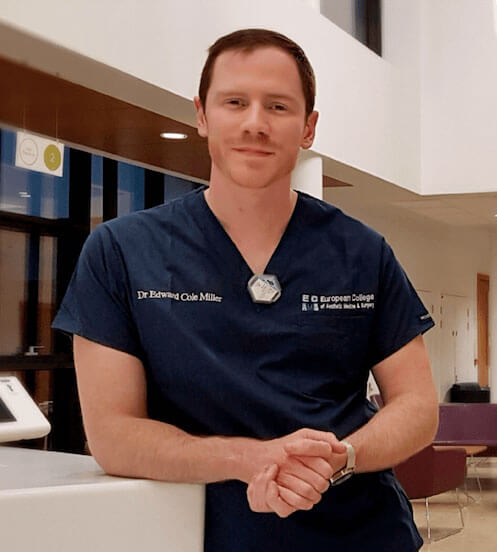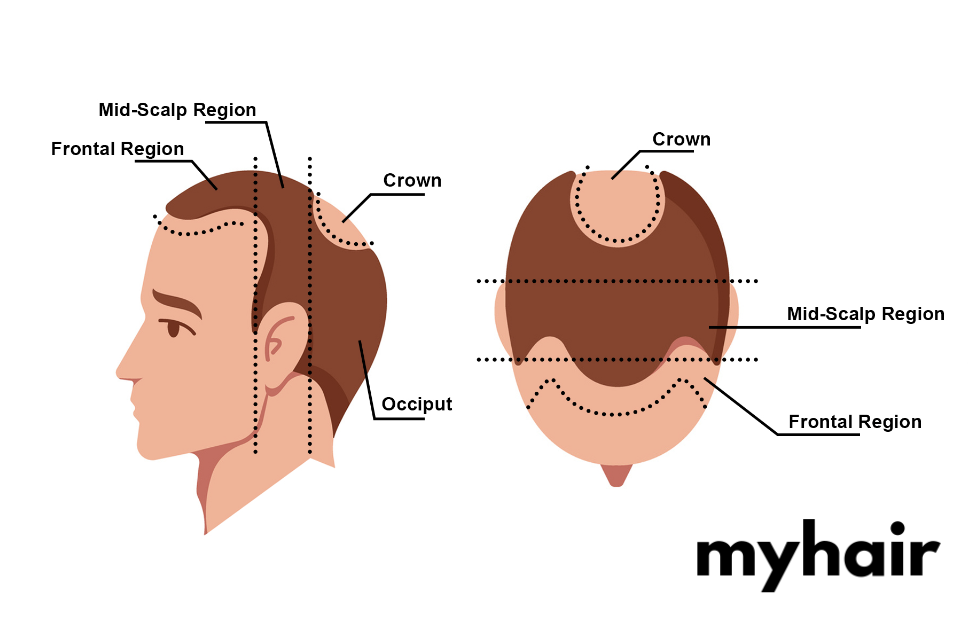When you hear the words stem cell transplant, your mind probably jumps to bone marrow and the transplants used to help people with cancers like leukemia and lymphoma. Bone marrow stem cell transplants are also used for many other conditions, from sickle cell anemia to severe combined immunodeficiency syndrome.
But bone marrow transplants aren’t the only type of stem cell transplants that exist. The UK’s National Health Service says that stem cells can be extracted from the blood left in the placenta and umbilical cord following a baby’s birth, as well as several other regions of an adult’s body, including fat tissue and circulating blood.
Stem cell hair transplants typically use stem cells taken from fat tissue. But in recent years, different stem cell hair transplant techniques have been explored. Researchers are currently developing follicle-derived stem cell transplantation techniques, which essentially involve the cloning of your body’s own hair follicles.
What does a hair stem cell treatment involve?
There are two main types of stem cell hair transplants: adipose-derived stem cell transplants and follicle-derived stem cell transplants. Adipose stem cell transplants always come from fat, while follicle-derived stem cells always originate from hair follicles.
Both adipose and follicle-derived stem cell hair treatments are autograft transplants – which means they exclusively use your body’s own cells. Autograft transplants are thought to be the safest type of transplants. Unlike organ transplants – which are allograft transplants that come from other individuals – you never have to worry about your body rejecting the cells or the treatment.
What is an adipose-derived stem cell hair treatment?
Adipose-derived stem cell hair transplants obtain stem cells from fat tissue and inject them into the scalp. According to a study in the journal Actas Dermo-Sifiliográficas, this technique specifically uses mesenchymal stem cells.
The initial procedure involved in adipose-derived stem cell hair treatments is similar to liposuction, the plastic surgery procedure that extracts excess fat to contour the body. But rather than disposing of the fat, as you would after liposuction, stem cells are extracted and conditioned. The stem cells are then injected back into the scalp around the regions you’d like to see hair regrowth.
Do adipose stem cell hair transplants work?
While adipose-derived stem cell treatments might sound very strange, a recent review in the Journal of Cutaneous and Aesthetic Surgery reports that adipose fat treatments for hair loss really work. They’ve been shown to help improve hair density, hair thickness, and the number of hair follicles in people with androgenic alopecia, a condition commonly known as pattern hair loss. These treatments are sometimes also able to help people with other types of hair loss, including scarring alopecias and autoimmune alopecias, like alopecia areata.
You should know that the benefits of adipose-derived stem cell hair treatments aren’t just thought to be related to the mesenchymal stem cells involved. According to a study in the journal Hair Transplant Forum International, the body’s fat tissue is believed to have beneficial anti-inflammatory properties and be able to promote the creation of new blood vessels. It’s also thought to have androgen hormone-blocking properties, which are particularly beneficial for people with pattern hair loss.
Because of this, adipose-derived stem cell hair treatments may be done in a variety of ways. According to the study in the Journal of Cutaneous and Aesthetic Surgery, adipose treatments for hair loss may include:
- Adipose fat transfer (from an area like the abdomen to the scalp)
- Extraction and transfer of the stromal vascular fraction (the population of stem cells and connective tissue cells found in adipose tissue)
- Nanofat transfer, which uses mechanically emulsified stromal vascular fraction
- Micrografts, a method that uses follicular stem cells found in adipose tissue
- Combined adipose-derived stem cell and platelet-rich plasma (PRP) therapy. PRP treatments extract platelets from the blood and inject them into the scalp.
What is a follicle-derived stem cell hair treatment?
Follicle-derived stem cell transplants harvest healthy hair follicles, grow more of them in a laboratory, then re-implant them back into the scalp. This type of stem cell hair transplant is often referred to as hair cloning.
While cloning hair follicles may sound simple, it’s actually fairly complicated. Hair follicles are made up of multiple cell types, not all of which are stem cells. And most institutions developing follicle-derived stem cell hair treatments are actually focused on cloning a specific type of cell within the hair follicles, rather than complete hair follicles. Cloning of complete hair follicles has yet to be achieved in humans.
In general, follicle-derived stem cell transplants tend to focus on cloning dermal papilla cells, a type of mesenchymal stem cell. A study in the Wound Repair and Regeneration journal says that these cells support hair formation, growth, and cycling. They are usually found at the bottom of hair follicles.
Is getting a stem cell hair transplant FDA-approved?
According to the Harvard Stem Cell Institute, no stem cell hair treatments are currently approved by the US Food and Drug Administration. In fact, the only stem cell-based treatments that are currently approved are blood stem cells for people with cancers or conditions that affect the immune system or blood.
However, several stem cell hair treatments are currently in clinical trials. EpiBiotech, TissUse, and The Riken Institute have all reported the intention to begin Phase 1 clinical trials in 2022. All three institutions are exploring follicle-derived stem cell hair transplant technology.
Other research institutions and organizations are also exploring stem cell hair transplants. For example, HairClone, a company based in the United Kingdom, was recently granted authorization to start cryopreserving and storing hair follicles. However, while tissue banking permission has been granted, this company seems to be a while away from starting clinical trials.
The closest stem cell hair transplant to FDA approval involves progenitor cells – the descendents of stem cells. RepliCel, a company focused on using a type of progenitor cell known as dermal sheath cells, has been isolating cells from patients, growing them in the lab, then implanting them into the person’s scalp. These cells are thought to both stimulate dormant hair follicles and help create new hair follicles. This progenitor cell therapy is currently entering phase 3 clinical trials.
Epibiotech’s stem cell hair transplant technology
Epibiotech is a Korean company exploring using dermal papilla cells, which are found at the base of hair follicles, for hair regrowth. Their research is based on obtaining these cells, culturing larger numbers of them, and injecting them into the areas of the scalp where people would like to regrow hair.
TissUse’s stem cell hair transplant technology
TissUse is a German company working with J. Hewitt, a Japanese biopharmaceutical organization. Their goal is to extract about 30 hairs from the back of the scalp, an area that is generally unaffected by pattern hair loss, in order to retrieve dermal papilla cells from this region. They aim to culture these cells to yield over 300 times the amount, then inject them back into the scalp. This stem cell hair transplant technology is known as the Smart Hair Transplant.
The Riken Institute’s stem cell hair transplant technology
The Riken Institute is using a new culturing method developed by Dr. Takashi Tsuji, which turns hair follicle-resident epithelial stem cells into functioning hair follicles. They aim to harvest, grow, and reimplant these cells in people suffering from hair loss. This technique may be one of the first functional applications of hair cloning.
HairClone’s stem cell hair transplant technology
HairClone’s idea is for follicles to be extracted across the UK, USA, Canada, Australia, and New Zealand, after which they would be stored at HairClone’s Hair Bank in the UK. Then, when needed, follicle cells would be retrieved, grown, and multiplied. These cells would then be injected into the parts of the scalp where people hope to see hair regrowth. While hair follicle banking is already available, the clinical trials related to implantation are only forecasted to start in a few years’ time.
Can you get a stem cell hair transplant now?
It’s possible to get a stem cell hair treatment at many hair loss clinics around the world. However, the U.S. Food and Drug Administration warns that unapproved stem cell therapies have the potential to be unsafe. A variety of serious adverse events have been reported, including:
- Administration site reactions
- Loss of function (of the tissue or organ) following injection
- Growth of tumors following injection
- Movement of cells from placement sites, causing them to change and/or multiply into inappropriate cell types
- Failure of cells to work as expected
“Even if stem cells are your own cells, there are still safety risks such as those noted above. In addition, if cells are manipulated after removal, there is a risk of contamination of the cells.“
What is the cost of a stem cell hair transplant?
Stem cell hair treatments aren’t standardized, FDA-approved procedures. This means they can vary substantially from clinic to clinic. Consequently, the effectiveness and cost of these procedures can also vary, ranging from as little as $1,500 to as much as $30,000.
If you’re interested in having a stem cell hair transplant, you may want to consider joining a clinical trial studying the procedure’s effectiveness, instead. Receiving such a procedure through a clinical trial would be at no cost to you. Just make sure that the treatment you’re seeking is part of a clinical trial or being studied under an Investigational New Drug Application (IND). The FDA says that INDs are clinical investigation plans submitted and allowed to continue under their approval.
If you aren’t able to join a clinical trial or your treatment isn’t IND approved, consider trying one of the hair loss treatments already approved by the FDA. You can use:
- Minoxidil: A topical hair loss treatment that’s sold as a liquid and foam
- Finasteride: An oral pill that you’d need to take once a day
- Laser hair therapy treatments: Red light devices you can use at home or treatments you can obtain at a hair loss clinic.
Can stem cells cure baldness?
Stem cell hair transplants seem very promising. At this time, adipose-derived stem cell transplants have been explored more than follicle-derived stem cell transplants.
Adipose-derived stem cells – along with other cells found in adipose tissue – have been shown to have a variety of benefits for hair growth. Adipose tissue has anti-androgenic and anti-inflammatory properties, as well as the ability to create new blood vessels.
Transplants involving adipose fat and adipose-derived stem cells have been shown to improve hair density, hair thickness, and the number of hair follicles within the scalp. They have even been combined with existing hair loss treatments, like PRP, to maximize improvements in hair regrowth.
Adipose-derived stem cell transplants have been found to help people with multiple types of hair loss, including androgenic alopecia, alopecia areata, and different forms of scarring hair loss. However, no adipose-derived stem cell transplants are considered to be cures for baldness.
Compared to adipose-derived stem cell treatments, follicle-derived stem cell transplants are much more experimental. However, several of these stem cell treatments entered clinical trials in 2022. While our knowledge of their benefits is currently limited, we may soon find that the benefits of follicle-derived stem cell transplants surpass those of adipose-derived stem cell treatments. It is possible that follicle-derived stem cells may be able to provide a cure for baldness, but we won’t know for several years.
For now, given how new stem cell hair transplants are, the FDA recommends joining a clinical trial or sticking with a treatment being studied under an Investigational New Drug Application. If neither of those options are accessible options to you, consider using a treatment like minoxidil or low-level laser therapy. Both of these are FDA-approved solutions for pattern hair loss.





